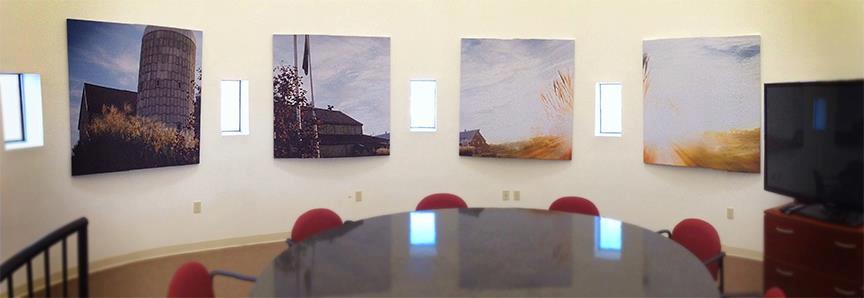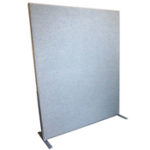
Open floor plans have become an established standard for newer companies, and there are many great reasons for them. These types of offices seem to foster creativity, facilitate communication and encourage a collaborative spirit in the workplace — but when you have an open office space, noise can be a real concern.
10 Ways to Reduce Open Office Noise
There are some proactive open office noise reduction strategies that you can apply to your situation. Here are the top ten ways you can reduce noise in an open office:
1. Provide Noise-Canceling Headphones
The highest quality noise-canceling headphones can make even the most open office feel like a private library.
Originally created for aircraft pilots, noise-canceling headphones are an incredibly effective solution available to the entire public. These headsets function by using microphones to sense and neutralize low-frequency noise before it hits your ear. They completely phase-invert the sounds they receive, resulting in two sounds that cancel each other out.
2. Create Quiet Spaces
Putting a room in your open office dedicated to quiet for employees to share can solve a lot of problems when it comes to soundproofing an open office. Your employees will know they can find quiet in this dedicated space, and others will know to respect their co-workers’ needs.
Conversely, you can dedicate a room meant for louder activity, too. If employees can escape to make a phone call, work out a tough problem or even just hear themselves think for a few minutes, it can make things much easier.
You can outfit a room with reliable sound dampening acoustic panels like Soundproof Cow’s fabric-wrapped acoustic panels to create a soundproof environment in your open office.
Shop Office Soundproofing Materials
3. Broadcast White Noise
Abrupt sounds and harsh noises easily break people’s focus. To combat these distractions, provide your employees with white noise machines or just place one in the center of the office to create waves of pleasing, harsh noise-masking frequencies that will help smooth out the cacophony of open office sounds.
White noise is an even combination of frequencies across the spectrum. It gives listeners a baseline of auditory stimulation that can prevent our brains from noticing other noises, making it a great tool for noisy offices.
4. Block Sound With Plants
Plants are great sound blockers and can improve the look and air quality of your office as well. Certain plants with dense vegetation work particularly well to block out sound. Many evergreen shrubs like junipers and hollies make for excellent noise-reduction because of their consistent distribution of thick branches. Place bushes along solid walls to amplify both of their sound-negating properties.
5. Use Furniture to Absorb Noise
Strategically placed furniture can block sound and create somewhat walled-off areas, even in an open floor plan, by adding a level of texture and some irregular surfaces to absorb and reflect sound. Sofas and upholstered chairs with plush fabrics like chenille, corduroy, microfiber and suede are particularly effective sound absorbers.
Place furniture as close as possible to your office’s most common noise sources to soak up the most sound. Curtains and tapestries work well, too.
6. Add Underlay to Flooring
Floors are often the hardest and loudest surfaces in your office, but you can put measures in place to reduce the amount of noise they reflect and soften noise from footsteps.
Vinyl or carpet floors with soundproofing underlay like Soundproof Cow Impact QT Floor Underlayment can cushion many of the impact-sounds that can cause problems in open offices, like people walking or running across the floor, dropped office supplies and chairs rolling around. These underlays provide effective sound dampening for office spaces and are easy to install.
7. Create a Strategic Office Layout
It is not just the furniture you can place strategically. Keeping all the noisy machines at the far end of the office from the employees is one of many ways you can create a sound-friendly layout. By combining other strategies with a thoughtful floor plan, you will cut down on a significant amount of noise that distracts your hardworking staff.
8. Install Acoustic Panels
You do not need to reserve our acoustic panels for the quiet room. You can easily install these effective, attractive panels anywhere in the office where you want to control sound.
Acoustic panels are made of compressed mineral wool or foam. They reduce noise by absorbing sound waves rather than reflecting them. When sound hits the porous foam, the panels rapidly vibrate and convert sound to kinetic energy (heat) that simply dissipates into the air. This way, a significant percentage of the sound produced in your office will be greatly diminished.
9. Add Office Partitions
An open office does not have to be completely open. Some strategically placed partitions can do wonders for sound control. These walls are made from fabrics like polyester or cotton and function similarly to acoustic panels. They absorb noise and convert sound energy into small amounts of heat that quickly dissipates.
Since they are not attached to the wall, soundproofing partitions are more easily moved around the room by one or two people depending on where you need them. In addition to sound reduction, they also provide visual privacy, allowing your employees to really be able to avoid the distraction of extra noise around them.
10. Use Soundproofing Insulation
A strong insulating barrier like our Quiet Batt® 30 Soundproofing Insulation is a great way to be more energy-efficient and control sound. Insulating your walls with soundproofing insulation will reduce noise from two primary sources — airborne and impact. Airborne sound comes from outside your building or in adjacent rooms. Impact noise occurs when something collides with your wall, like when someone knocks or bumps into it.
Thicker insulation will increase the amount of sound your walls keep out, no matter the source. Additionally, stronger insulation also increases your office’s energy efficiency by holding in heat during the winter and keeping it out during the summer.
.
The Importance of Reducing Noise in an Open Office
Anytime you get a large number of people in the same space, sound will become an issue. This is the case with most open offices. Surveys show that noise is among the most prolific factors impacting office productivity.
In an open-plan office, phone calls and conversations between coworkers occur out in the open. Everyone can hear them, even at library volume. The chatter can distract some coworkers and bleed into others’ phone calls or video meetings.
Beyond distractions, all of these situations run the risk of private information reaching the wrong ears. Other little sounds like a constantly clicking pencil or a tirelessly tapping foot can chip away at coworkers’ patience. In a wide-open room, conversations and distracting sounds can travel unincumbered, reaching those at every end.
Researchers find that workers ages 35 to 44 — who represent the second largest portion of the workforce — are the most frustrated with the distractions and poor privacy in noisy offices. Easing these frustrations will be an important part of maintaining productivity.
The Acoustic Challenges of an Open-Plan Office
Employees experience noise-related distractions and privacy concerns due to the open floor plan’s distinct acoustic challenges, those being:
- Prominent echoes: Large rooms with a uniform shape increase acoustic phenomena, like sound reflections, making echoes more noticeable.
- Long reverberations: The reflections that cause reverberation travel farther and for longer, increasing their impact.
- Uneven sound distribution: Sound reaches nearby and distant surfaces at vastly different times and reflects at numerous angles.
- Sonic flutters: Long, narrow open-plan rooms allow reflections to occur at a higher rate, causing a rapid echo that drastically outlasts the original noise.
- Disproportionate sound concentration: If an open-plan room features rounded ends, corners or recesses, sound can congregate in those spaces.
Improve Productivity and Privacy in the Office
Workplace distractions cause significant productivity loss, and noisy office environments are among the most reported distractors. One study found that reducing speech volume from 50 A-weighted decibels (dBA)to 38 dBA caused subjects to complete more math problems and improved accuracy. Higher levels of background noise and speech resulted in lower efficiency.
Another study shows that increasing the dB level during employee training reduces productivity despite effort remaining the same. If workers are more productive when you reduce workplace noise, then office noise reduction solutions can benefit workers in open-plan offices. Acoustic treatments absorb reflections to reduce background noise, helping to create a more productive office environment.
Request an Acoustic Analysis of Your Office
Reducing ambient noise can have a significant impact on workplace productivity. Soundproof Cow can tailor an acoustic solution to your open-plan office’s exact dimensions, so contact us online to request a free acoustic evaluation.
















